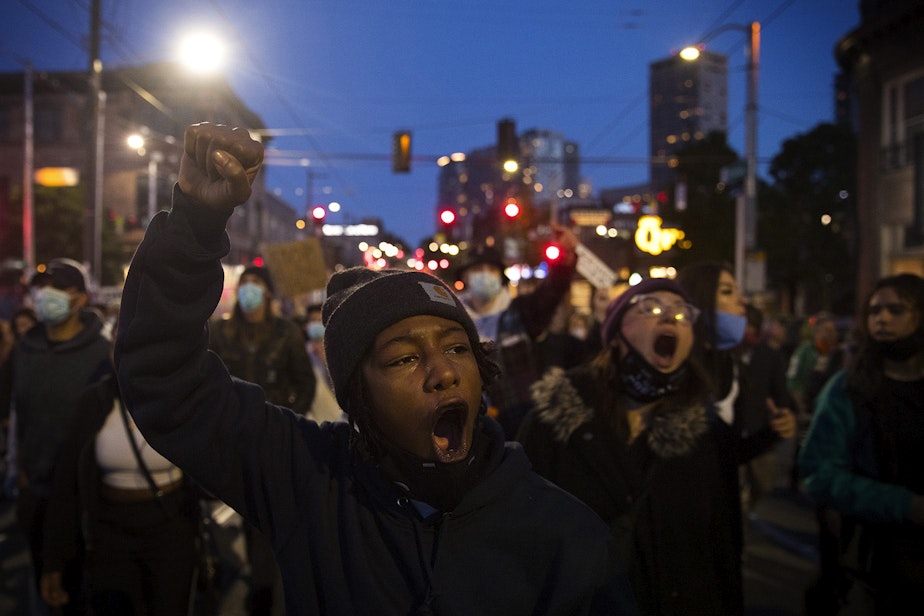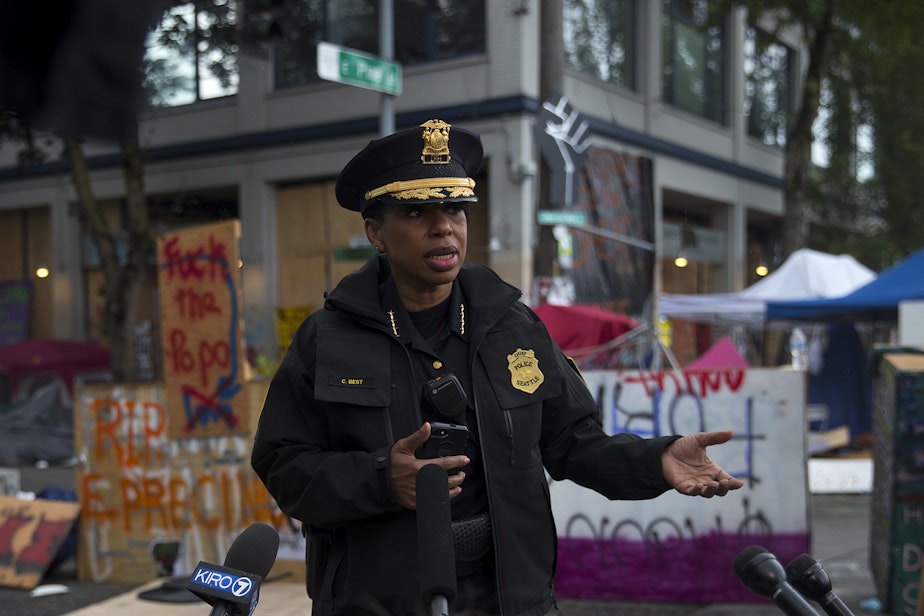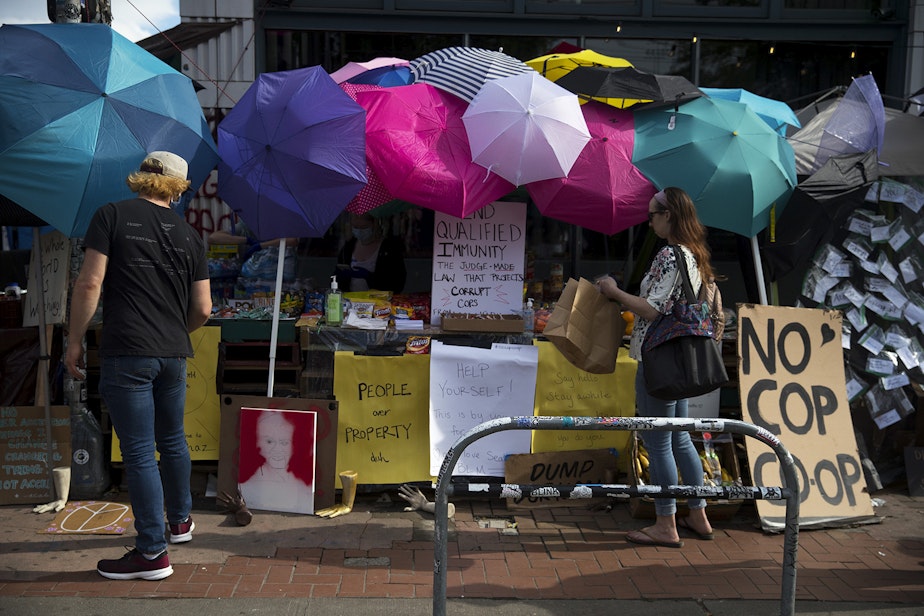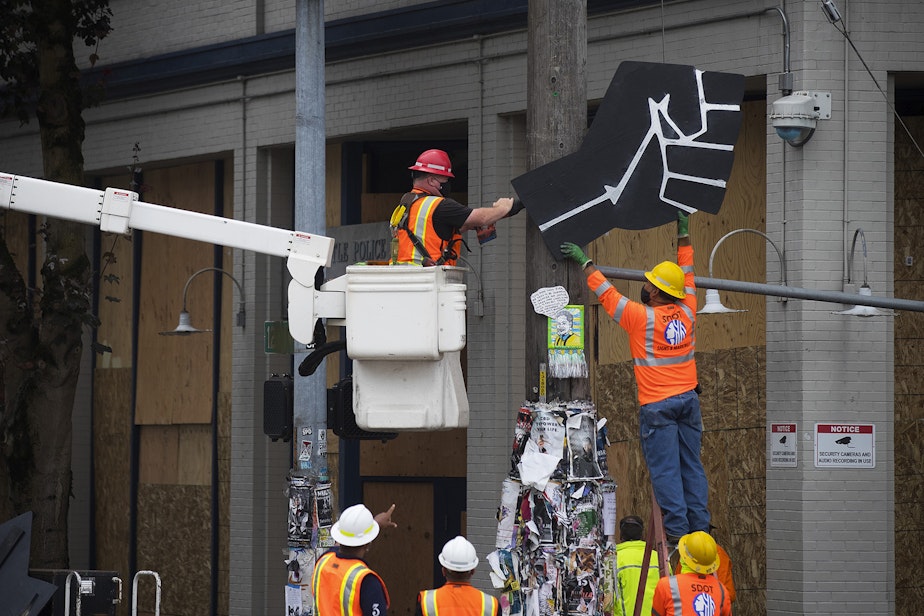The final days for CHOP— but not the end of a Seattle movement against racism, police violence

People congregating within the four city blocks of the Capitol Hill Organized Protest zone were coming to terms with what had unfolded the night before.
It was June 29, hours after bullets again rang out near the autonomous zone — the fourth shooting in nine days, and the second which resulted in a loss of life. The two people killed at CHOP were both Black men.
The mood at the autonomous zone was more somber than the weeks before and the volume of people within the zone had dwindled. The baseball field of Cal Anderson Park, which on June 12 was full of at least 100 people chanting “Black Lives Matter” was now sparsely populated.
Shannon Alberts, 28, has spent many nights in the autonomous zone, in her push for police reform. She has kept close to the East Precinct, which the Seattle Police Department vacated in early June after daily protests against police brutality attracted hundreds to a police barricade on a block of 12th Avenue.
Police used tear gas, pepper spray, and rubber bullets in an attempt to disperse the crowd of protesters, who stood for hours against the barricade, shouting and chanting in unison.
Seattle Police voluntarily abandoned the precinct for more than three weeks. Officials never publicly reached a consensus on who made this call or why.
The vacated blocks were soon after filled with art, makeshift healing centers, and teachers who provided willing participants an education on racism in America. The CHOP attracted hordes of onlookers to what has been called a "social experiment" and people who worked to fill what they called resource gaps in Seattle.
Alberts was one of a cohort of protesters who vowed to remain in the space, despite the violence that infiltrated CHOP, the calls by Seattle Police Chief Carmen Best for people to leave, lawsuits that had emerged, and condemnation from President Donald Trump.
“Literally what we were protesting is continuing to happen. How on Earth could we leave? Nothing's changed, except the opportunity for other hearts to wake up,” Alberts said.
CHOP protesters recognized that their demands — which differ depending on who you ask — had not yet been met, although discussed by city leaders. They intended to hold until those demands were implemented.
Jesse Miller, executive director of the Harriet Tubman Foundation For Safe Passage, was present at the CHOP on Monday. She was there to raise protesters’ spirits, she said.
“There are different voices here in CHOP, as you understand are the different voices of Seattle, but we are collectively saying 'no more',” Miller said.
The three demands that appeared to circulate most widely were: Defund the Seattle Police Department by 50%, invest more resources in Black and brown communities, and release protesters who had been arrested without filing criminal charges.
“The bigger and broader statement here is, 'equity and equality for all',” Alberts said. Alberts and others remained hunkered down outside the precinct.
Other protesters opted to leave and refocus their energy in the movement elsewhere. One of those places was outside the home of Seattle Mayor Jenny Durkan.

Back on Capitol Hill, Chief Best on Monday urged people to avoid the area occupied by protesters.
“We’re asking that people remove themselves from this area for the safety of the people,” Best said to a group of reporters that morning. “If they care about people, they’re gonna have to try to help us to make it safe.”
RELATED: Seattle police force protesters out of CHOP zone, make arrests
There were less emergency calls made to Seattle Police in the area constituting the CHOP in June 2020 than in June 2019, according to data compiled by the department. But the number of shots fired, homicide, and assault calls had gone up.
Best said the uptick in violence was a product of CHOP, and that police needed to regain access to the East Precinct building, to better serve the community. Protesters argued that the violence had always existed, and had their own ideas on what should become of the East Precinct.
One idea was to turn the building into a “de-escalation center,” “because policing would be abolished and the officers would be repurposed into de-escalation officers,” Alberts said.
Another thought was to remodel the precinct as a hub of community resources, to provide needed mental health and social services.
“There's a lot of different voices out there about what needs to be done with this building, and I think the bottom line is that it needs to be reimagined, period,” Alberts added.
Occupying space to create change has proven effective in Seattle’s past.
Larry Gossett, a long-time activist and former County Council member, was involved in the occupation of the Beacon High School in 1972, which would later become El Centro de la Raza. The occupation, fueled by demands that the city repurpose the school to be a Latino community center, lasted three months.
In the 1960s, Gossett organized sit-ins at the University of Washington for social change and better treatment of students. He pushed for the university to expand its curriculum to include non-white history and improve Black representation on campus.
Gossett said the outpouring of community action happening around the nation, as a result of mounting outrage over police killings that disproportionately impact Black Americans, was impressive.
“Because [the action is] so broad, it reminds me of the ‘60s. But it's much broader in terms of ethnicity, age, and sector of population participation,” he said.
When it came to Seattle's movement, a balanced approach is needed, Gossett said.
"Once we get organized management about what we want, and get people from all the communities to agree on that, we can work together to have the changes that we need actually happen," Gossett said.

On Monday, Maehem, a woman with multicolored braids in her hair, was preparing for another day of helping to feed hundreds of people in the CHOP.
“My goal has always just been to feed the revolution,” Maehem said while standing in Cal Anderson Park.
Maehem first began this effort by making sandwiches, and she now works with others to serve a hot meal twice a day in an on-site kitchen. The donations given to her sandwich-making fund made that feasible.
She estimated that about 400 people attended dinner.
“Now that I know that this is possible ... to feed people for free, I kind of just want that movement to just keep going because I think everyone deserves to eat,” she said.
Maehem wondered what would become of the community garden set up by Marcus Henderson and others. Or, what would happen if the police were to disband the tents set up in Cal Anderson Park, where people without homes said they felt safe?
“Leave this area and go where?” Maehem said. “Some of us are privileged enough to go back to a house, but there are a lot of people in here that don't have that privilege … where do you want them to go?”
Mayor Durkan pledged to help the people living in tents at Cal Anderson Park. Durkan also directed city staff to develop scenarios in which the police department's 2021 budget is cut by 20%, 30%, and 50%, respectively, and vowed to invest in Black, Indigenous, and people of color communities.
READ: Seattle City Council readies to cut policing budget, and more
The mayor’s word, however, was hard for protesters to believe. But remaining at the CHOP was even harder for others to justify.
Marty Jackson, a volunteer medic who treated the two victims of the fourth shooting, didn’t think the CHOP protest should continue.
“Now it's like pretty much an active war zone. Now you have security and medical always looking around, waiting to see,” Jackson said Monday morning.
His statement echoed what Andre Taylor, founder of the police accountability advocacy group Not This Time, said during a June 22 press briefing.
"Are you willing to die?" Taylor expressed to CHOP leaders. "And not only are you willing to die, are you willing to take the responsibility of someone who dies on your watch?"
Taylor has organized meetings between Seattle Mayor Jenny Durkan and protesters. He helped to facilitate a discussion between Durkan and the CHOP protesters on June 26. The group of protesters presented the mayor with a list of demands.
No live streaming or live tweeting was allowed during the meeting. Citizen journalist Omari Salisbury briefed reporters on the closed-door meeting once it was over.
“The mayor went through and she struck a lot of these demands, right off the top,” Salisbury said. “She said that either the city has met the requirement, was on the way to meeting the requirement, or it was out of the city’s hands.”
But there were three demands that the community has called on the city to meet: Defund the Seattle Police Department by 50%, reinvest that money into Black and brown communities, and free all protesters without pressing charges.
James Bible, civil rights attorney and former head of the King County NAACP, said occupation movements have a history of effecting change and creating space for people.
What is key to creating change, Bible said, is a “willingness by the power structure to evaluate what’s going on and working toward authentic and meaningful action.”
On Tuesday morning, the cement barricades that had blocked off portions of the streets comprising CHOP were removed by the city. Couches and trash cans were put in place as makeshift replacements. A sign of three demands was propped up on the blockade.
Later that evening, Alberts shared a working draft of a mission statement drawn up by those who remained. It was written out on lined notebook paper.
“We the people, will continue to fight for the marginalized and the oppressed by systemic racism and will tear down the social injustices and systems by reinforcing and funding social, mental, education and community services.”

The next morning, on Wednesday, police moved into the CHOP. Mayor Durkan had issued an executive order for people to vacate the area. Tents were torn down. Signs were taken out. People were arrested.
By 8 a.m., police had arrested 23 people for failure to disperse, obstruction, resisting arrest, and assault. A new video surfaced online that showed Seattle Police officers kneeling on the neck of a protester, as they detained him.
On Wednesday afternoon, White House press secretary Kayleigh McEnany declared CHOP a “failed experiment” and said Seattle had been "liberated" during a press briefing with reporters.
“Anarchy is anti-American. Law and order is essential. Peace in our streets will be secured,” McEnany said.
However, the resistance and organizing efforts in Seattle continued. More rallies to free protesters and defund the police were planned.
At 9 p.m. on Wednesday, a group of people was growing in size on Broadway and Pine streets, just outside of the former CHOP area now quartered off by police. The familiar sound of chanting rang out.
"It's like we're back at day one," Alberts said, as she directed car traffic away from the protesters occupying the middle of an intersection.
"For them to say that we should just go home, that's just them trying to kill the movement and have us go back to normal. And that's what this is about."

